Is Energy Planning Consistent with Climate Goals? Assessing Future Emissions from Power Plants in Latin America and the Caribbean
Date
Oct 2023
At least ten Latin American and Caribbean countries have pledged to achieve carbon neutrality. Has electricity planning in the region evolved towards reaching these goals? We compare power generation capacity in 2023 to announced plans in 2019. We then estimate committed emissions from existing and planned power plants that is emissions that would result from the normal operations of these plants during their typical lifetime and compare them to emissions from power generation in published IPCC scenarios. We find that fossil fuel planned capacity has decreased by 47% since 2019, mainly due to the cancellation of 50% of coal and 40% of gas projects, compared to an increase of 24% of renewable energy projects. But existing plants in the region will emit 6.7 GtCO2 during their lifespan, and if all planned plants are built, they will add 4.9 GtCO2, totaling 11.6 GtCO2, exceeding median carbon budgets for 1.5 and 2C - consistent IPCC pathways (2.3 and 4.3 GtCO2). Natural gas power plants are the largest contributor to existing (62%) and planned (75%) emissions (versus 24% and 23% for coal). We evaluate emissions reduction strategies to achieve carbon budgets. Assuming no new coal plants come into operation, announced gas and oil projects are canceled at the same rate as in the past four years, all fossil fueled plant lifetimes are reduced by 10 years, and all new natural gas displaces existing coal, committed emissions fall by 67%, meeting the 2C budget, but still twice as large as the median 1.5C budget. Our results suggest that while progress is being made, energy planning in the region is not yet consistent with global climate goals as reflected by the IPCC scenario database.




